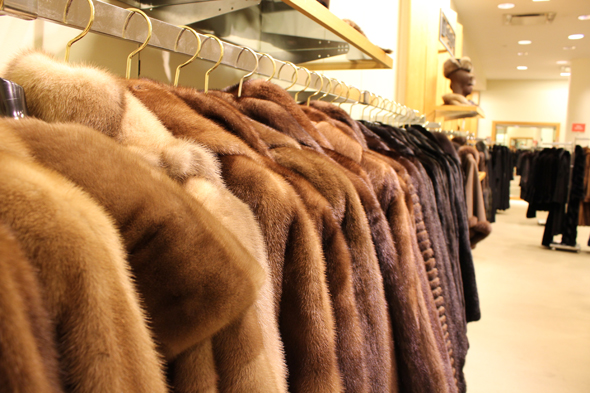
New Yorkers, like Steven Lanzillotta’s clients at The Fur Vault at Macy’s, are calling their furriers to reclaim their fur coats from hibernation in cold storage, where they are stored during the summer months. Every spring, fur storage warehouses across the United States check in glossy mink, sable, fox, chinchilla and rabbit fur garments, millions of them, to hang in climate-controlled enclaves outside of Manhattan at a steady 48 degrees.
Keith Kaplan, Executive Director at the Fur Information Council of America, said that some companies store as many as 12,000 coats at one location. “With 1,100 retail doors across the U.S you can see how extensive storage can be.” Kaplan said.
Stephanie Stokes, a loyal client at Madison Avenue Furs, wore an all-black outfit to her appointment at her furrier’s workshop, channeling the later-years Audrey Hepburn, except for the fact that Stokes’ cropped haircut was blonde. She was there to collect four coats.
Stokes, a veteran wearer of fur said, “I just pulled them out of storage and the discipline is that I fix them.” Or rather, Madison Avenue Furs maintains them for her, under the careful guidance of third-generation furriers Jerry, Larry and Steve Cowitt. Their business has been on West 29th Street, on the outskirts of the Garment District, for over 75 years — and each season they care for Stokes’ coats, altering them as necessary to keep them looking up-to-the-minute, with the latest silhouettes and trims.
“If I left them in the basement and it gets to be 90 to 100 degrees, I was told that it disintegrates the skin,” said Stokes.
However, animal activists complain about what’s involved in turning fur into a fur coat: Ryan Huling, a spokesperson for People for the Ethical Treatment of Animals, said that toxic chemicals, including sulfuric acid and formaldehyde, are used with ammonia to keep the furs in pristine condition, at the fur farms where fur coats are originally made.
But once that process is finished, fur experts say the coats have a clean bill of health. Barry Kirsch owns Central Fur Storage, which was established in 1948 and now holds 150,000 fur garments each season at a New Jersey storage location. Kirsch said that nothing that could be harmful to clients or the coats are used in the cleaning process that many customers choose to have done while their coat is stored. As for clients who wish to have their mothers’ thirty-year-old mink glazed, nothing more than mild heat is applied to the fur.
“Cold storage is a simple process of placing coats on racks in temperature and humidity controlled environments,” said FICA’s Kapln. “No chemicals or solvents whatsoever are applied to the coats.” He said the practice stems from the mid-1800’s where Victor Revillon, a French furrier, designed and patented the first cold-storage facility for furs.
Steve Cowitt, also a member of FICA, said that when any animal skin is used for clothing it must be treated, for example by tanners and fur farms, but that today the practices are highly regulated by organizations like the International Fur Trade Federation and the Environmental Protection Agency. “I took the time to visit farms, go out with trappers and visit retailers before taking on the assignment,” said his colleague Kaplan, “and I learned the truths about the industry first hand.”
Steven Lanzillotta, the manager of The Fur Vault at Macy’s and furrier for some 30 years said it’s appropriate to “think green” when in comes to wearing fur, since it can be worn season after season, sometimes for generations, a renewable material for keeping warm in the chilly New York winters.
But Huling disagrees: “it’s kind of intuitive, to think that furs are a part of the natural ecosystem. They biodegrade, and to unnaturally preserve them is wrong.”